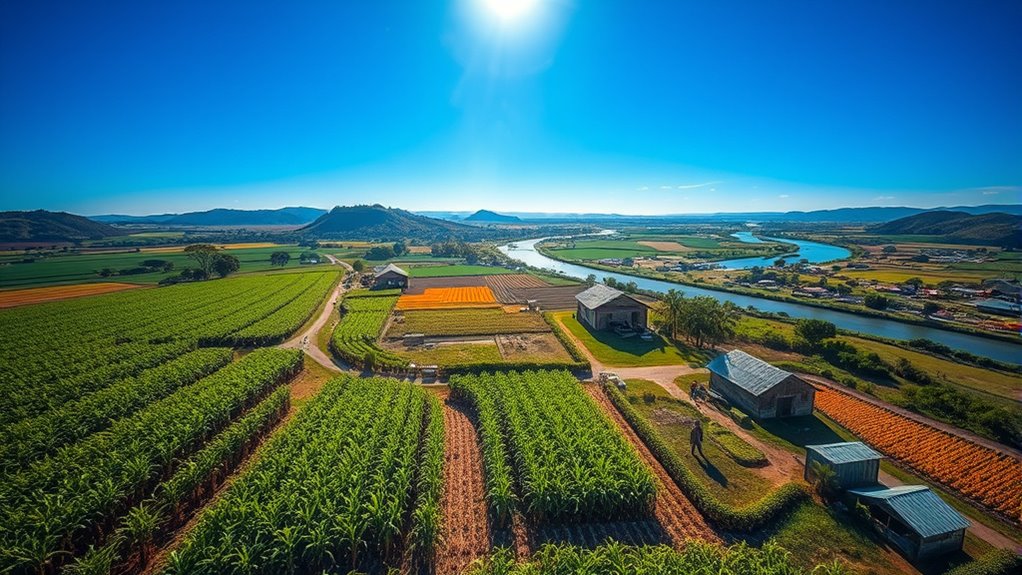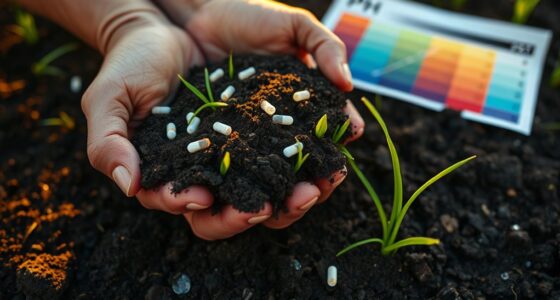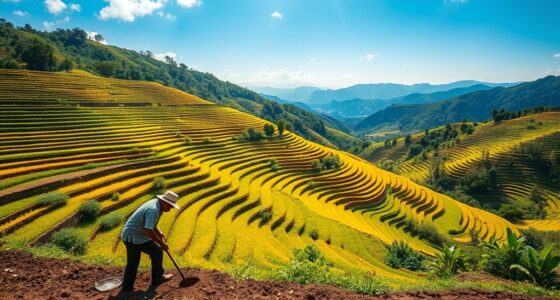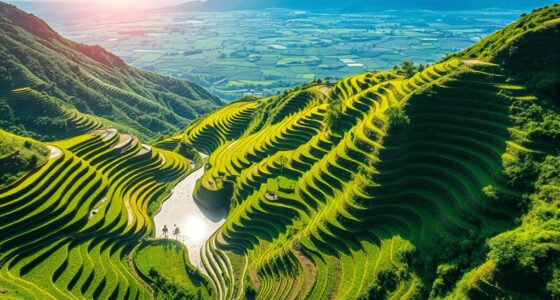Plantation agriculture is practiced today primarily in tropical regions around the globe, like Southeast Asia, Central and South America, and West Africa. You'll find vast fields producing high-demand cash crops such as cocoa, coffee, and oil palm. These plantations play a significant role in local economies by creating jobs and boosting exports. However, they also face environmental challenges. There's so much more to discover about the impacts and trends shaping this sector.
Key Takeaways
- Southeast Asia is a major region for oil palm, rubber, and coconut plantations.
- Central and South America are known for the cultivation of coffee, cocoa, and bananas.
- West Africa focuses heavily on cocoa and palm oil production.
- East Africa specializes in tea and coffee plantations.
- Pacific Islands are notable for their coconut and pineapple plantations.
Overview of Plantation Agriculture

Plantation agriculture is a vital part of the global farming landscape, focusing on large-scale cultivation of single crops for profit. Originating during colonial times, this method has thrived by producing valuable commodities like sugar, coffee, and rubber.
You'll find that key crops include tea, cocoa, and oil palm, all contributing significantly to national incomes and the global agricultural economy.
However, this system isn't without its challenges. The reliance on monoculture increases disease susceptibility, and the need for significant capital and manual labor makes it labor-intensive.
The challenges of plantation agriculture include monoculture's disease susceptibility and the intensive labor and capital requirements.
Environmental concerns, such as deforestation and biodiversity loss, further complicate the picture.
Major Tropical Regions for Plantation Crops
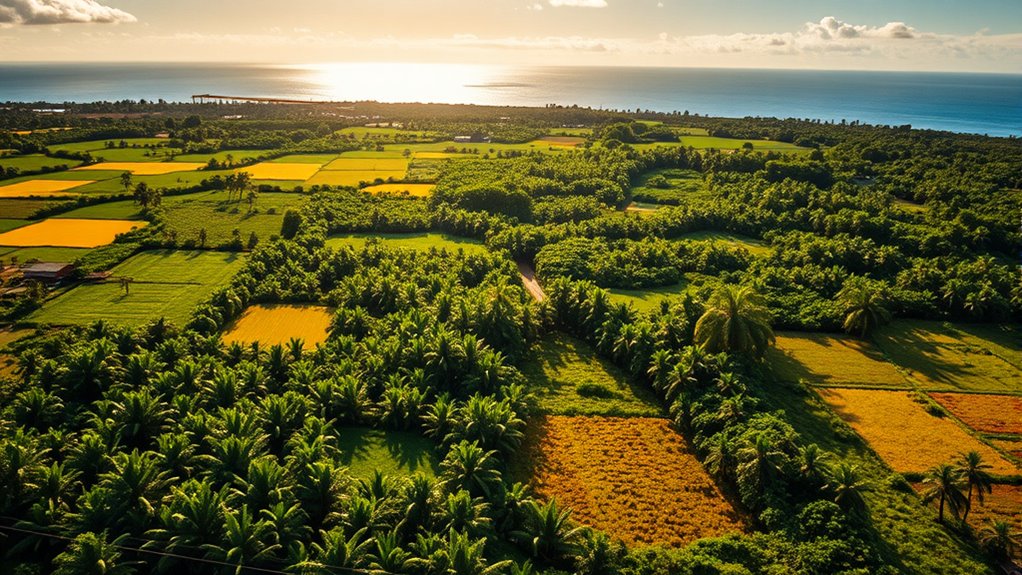
While exploring the world of plantation crops, you'll discover that major tropical regions play a crucial role in their production.
Southeast Asia stands out, with vast plantations of oil palm, rubber, and coconut. In Central and South America, coffee, cocoa, and bananas thrive, significantly contributing to local economies.
West Africa is known for its cocoa and palm oil, while East Africa focuses on tea and coffee cultivation.
You'll also find coconut and pineapple plantations flourishing on the Pacific Islands.
Each of these regions not only provides essential crops but also faces challenges like environmental impact and market fluctuations.
Understanding these areas helps you appreciate the global significance of plantation agriculture today.
Key Cash Crops and Their Producers
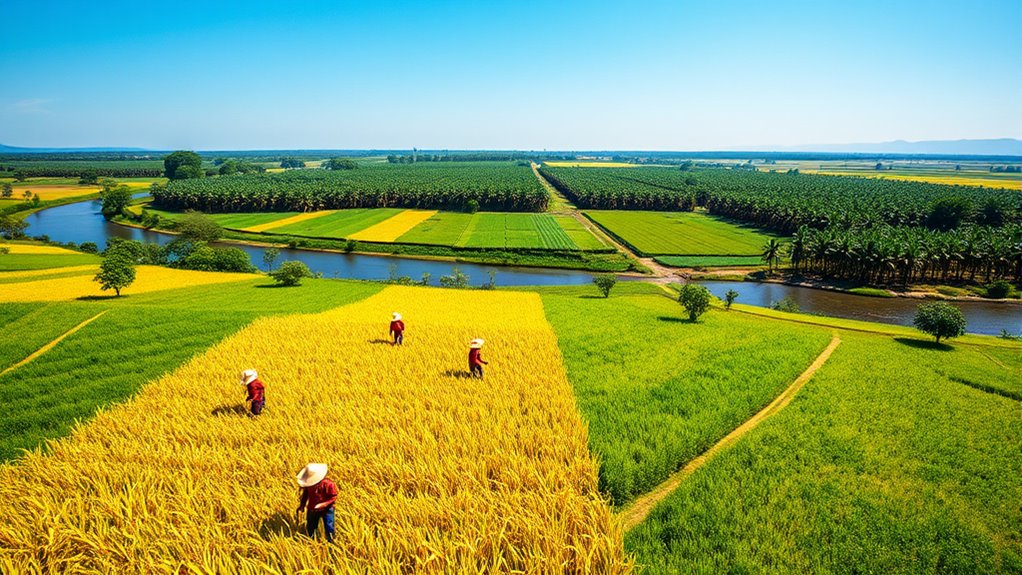
Cash crops play a vital role in global agriculture, driving economies and shaping livelihoods across various regions.
You'll find rice thriving in Asia, especially in China and India, while maize, or corn, is predominantly produced in the United States, China, and Brazil.
Wheat production flourishes in China, India, and the U.S., contributing significantly to food supplies.
When it comes to soybeans, the United States, Brazil, and Argentina lead the way.
Brazil, India, and China are your go-to places for sugar cane.
Each of these crops not only boosts local economies but also creates jobs and influences global market prices.
Understanding these key crops and their producers can help you appreciate the interconnectedness of agriculture worldwide.
Impact of Climate on Plantation Agriculture
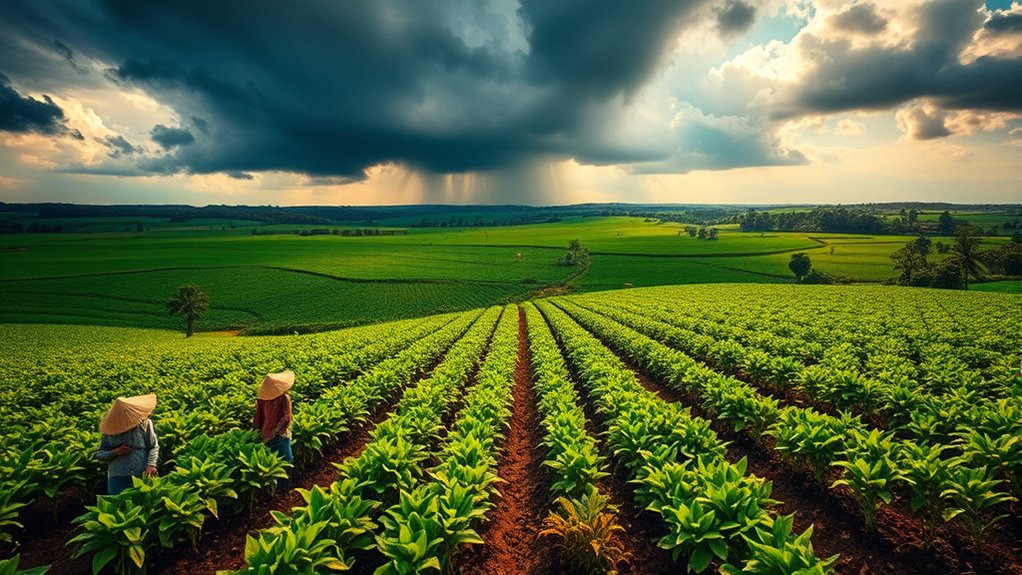
As climate change continues to reshape our environment, its impact on plantation agriculture has become increasingly evident. Rising temperatures stress crops, reducing yields and hindering growth.
Changes in precipitation patterns can trigger droughts or floods, compromising soil moisture and overall health. You might notice more extreme weather events damaging crops and infrastructure, while increased rainfall intensity leads to soil erosion, harming fertility.
Additionally, warmer conditions can boost pest and disease prevalence, demanding more intensive management. Different crops respond uniquely to these changes, causing yield variability across regions.
Adopting climate-resilient practices is crucial for mitigating these challenges, ensuring sustainable productivity, and preserving biodiversity. Ultimately, the future of plantation agriculture hinges on adapting to these climate impacts.
Economic Significance of Plantations Globally

Plantation agriculture plays a vital role in the global economy, contributing to job creation, foreign exchange earnings, and infrastructure development. It provides employment to millions, especially in rural areas where jobs are scarce.
The export of plantation crops like coffee and palm oil generates significant foreign exchange, bolstering trade balances and driving economic growth. In developing countries, plantations significantly contribute to GDP and fuel infrastructure improvements, including roads and processing facilities.
However, while these benefits are substantial, plantations also face challenges such as market fluctuations and labor issues. By focusing on export-oriented production, regions like Southeast Asia and Latin America become crucial players in the global market, enhancing their economic significance.
Environmental Challenges Facing Plantations
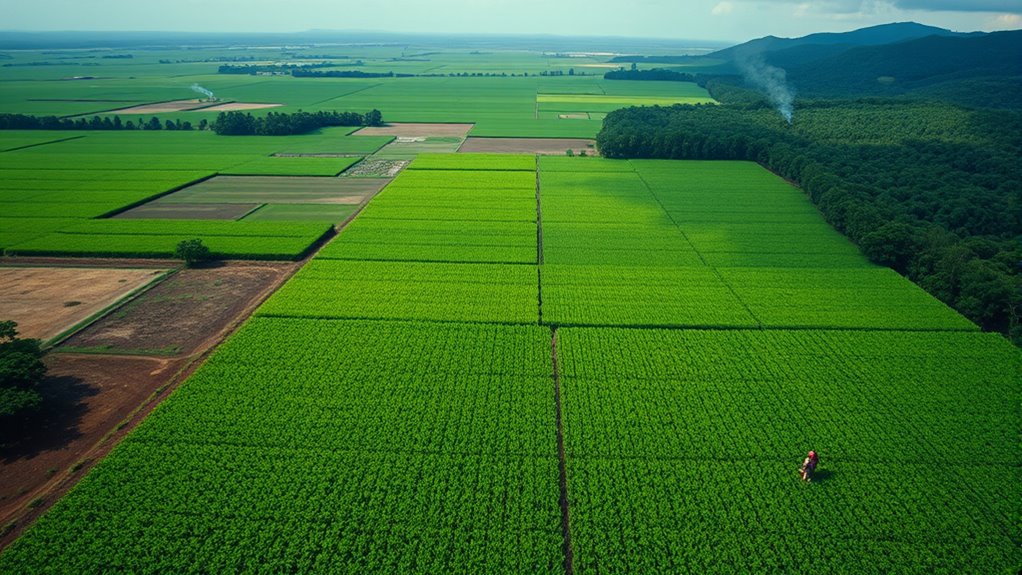
While plantations contribute significantly to the economy, they also pose serious environmental challenges that can't be ignored.
Deforestation is rampant, particularly in biodiversity hotspots, threatening species and ecosystems. For instance, oil palm and soy plantations have decimated forests in Southeast Asia and South America.
Additionally, intensive water use can deplete local supplies, while agricultural runoff pollutes waterways.
Soil degradation is another concern, as monoculture practices and chemical fertilizers lead to erosion and nutrient loss.
Plantations also contribute to greenhouse gas emissions, particularly during deforestation.
Lastly, they often reduce biodiversity by replacing rich ecosystems with monocultures, harming wildlife and pollinators.
Addressing these challenges is essential for sustainable plantation agriculture and environmental health.
Technological Innovations in Plantation Practices
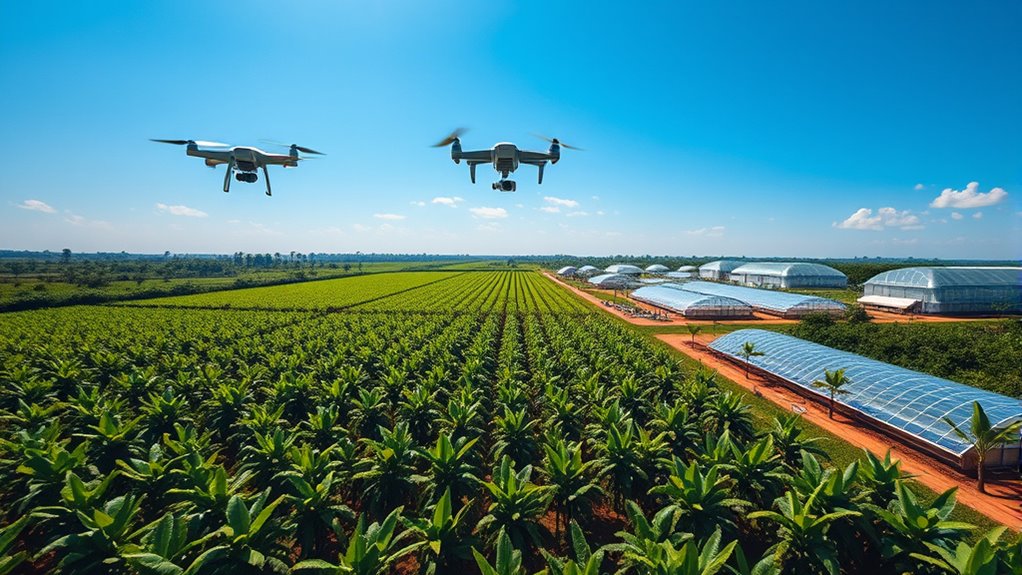
With the rapid advancement of technology, the landscape of plantation agriculture is transforming dramatically.
The rapid advancement of technology is dramatically transforming plantation agriculture, paving the way for innovative practices and enhanced sustainability.
You might find precision agriculture, utilizing GPS and IoT sensors, optimizing farming practices for better efficiency and sustainability. Drones are now essential for aerial monitoring, applying fertilizers, and assessing crop health.
Automated machinery, like self-driving tractors, cuts labor costs and boosts precision. Nanotechnology is enhancing nutrient use with nano-fertilizers, significantly reducing waste.
Vertical farming is gaining traction, maximizing space in controlled environments. Genetically engineered seeds lead to higher yields, while variable-rate technology optimizes resources.
Real-time data from sensors enhances decision-making, driving productivity and sustainability. These innovations are reshaping how you manage and cultivate plantations today.
The Role of Smallholders in Plantation Agriculture
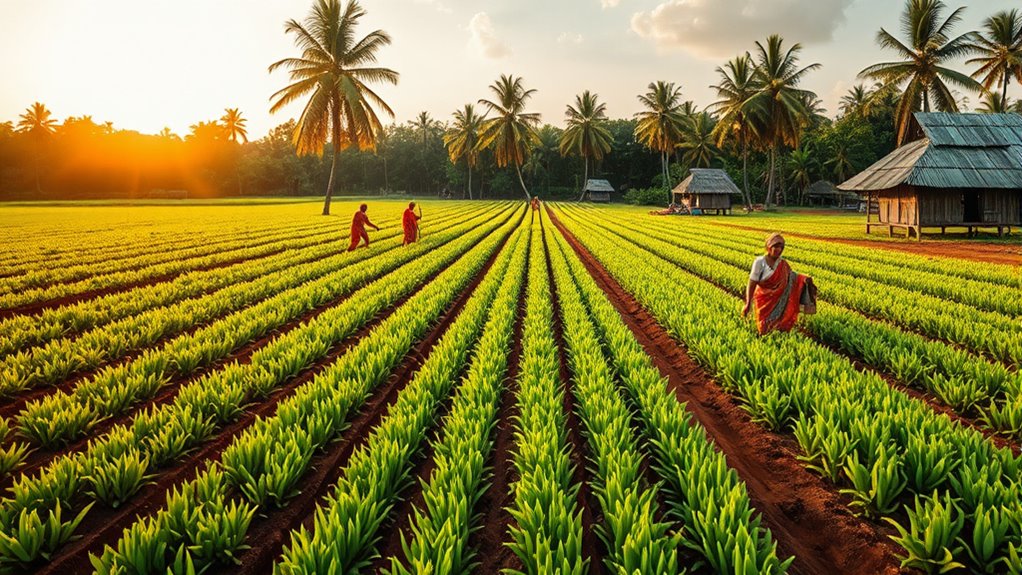
Smallholders play a vital role in plantation agriculture, cultivating crops on small plots that often contribute to local food systems and even global markets.
Despite facing challenges like limited access to finance and technology, you help sustain global food production significantly. Your practices, such as agroforestry and intercropping, promote sustainability while enhancing community food security.
Engaging in contractual arrangements with larger plantations allows for better market access, although you still rely on intermediaries. By diversifying crops, you maintain biodiversity and reduce environmental impact compared to monoculture plantations.
Joining cooperatives can also strengthen your bargaining power, helping you navigate market fluctuations. With support initiatives focused on training and resources, your contributions can continue to thrive and impact local economies positively.
Future Trends in Plantation Farming
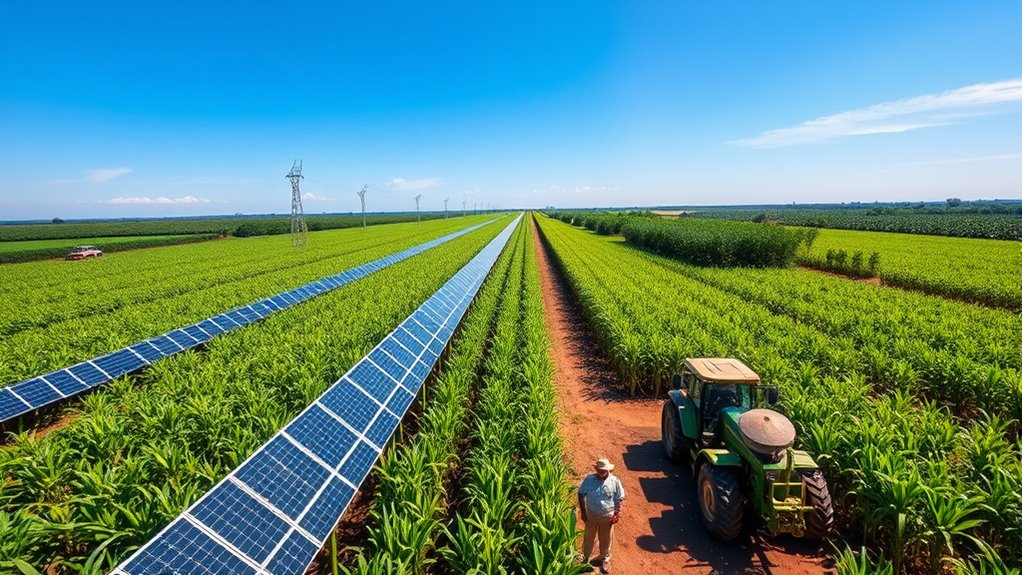
As technology transforms agriculture, plantation farming is poised for significant advancements that promise to reshape the industry.
You'll see increased adoption of IoT and AI, enhancing monitoring and decision-making processes. Precision farming tools like drones and GPS will optimize your crop yields and resource use. Automated machinery will streamline planting, maintenance, and harvesting, cutting labor costs.
Embracing sustainability, plantations will implement regenerative practices and efficient irrigation systems, ensuring water conservation and improved soil health. With growing global demand for sustainably produced crops, you'll witness economic growth and job creation in local communities.
Frequently Asked Questions
What Are the Labor Conditions on Modern Plantations?
On modern plantations, you face tough labor conditions.
Workers often struggle with inadequate access to clean water and poor housing. Low wages, sometimes as little as £1.50 per day, are common, and many endure debt bondage or forced labor.
Safety gear is often lacking, exposing you to hazardous chemicals.
While the industry contributes to local economies, these challenges highlight the urgent need for better enforcement of labor laws and improved worker rights.
How Does Plantation Agriculture Affect Local Communities?
You'd think plantation agriculture is a local community's best friend, right? Well, not quite.
While it creates jobs, it often exploits workers, leaving them in economic uncertainty. Sure, you get some cash flow, but good luck when the plantation owner pockets most of the profits.
Plus, traditional cultures can get steamrolled in the process.
What Role Do International Trade Agreements Play in Plantations?
International trade agreements play a crucial role in shaping plantation agriculture. They reduce tariffs, making your crops more competitive internationally, and enhance market access through pacts like the USMCA.
You'll also find that these agreements address non-tariff barriers and promote sustainable practices, which can lead to better prices for your produce.
However, the mixed effects on producer prices due to competition highlight the need for careful navigation in this global marketplace.
Are There Certifications for Sustainable Plantation Practices?
Like a lighthouse guiding ships through turbulent waters, certifications for sustainable plantation practices illuminate the path toward responsible agriculture.
You'll find various certifications, such as Rainforest Alliance and RSPO, promoting environmental stewardship and fair labor conditions.
These standards not only enhance market recognition but also ensure compliance with global sustainability goals.
How Do Climate Change Effects Vary by Region in Plantations?
Climate change effects on plantations vary significantly by region.
You'll notice that some areas experience rising temperatures and longer growing seasons, boosting yields for certain crops. Meanwhile, others face extreme heat and drought, leading to decreased productivity.
Precipitation patterns also shift, impacting soil moisture differently.
Conclusion
In conclusion, plantation agriculture continues to flourish in tropical regions, weaving a rich tapestry of economic activity and cultural heritage. As smallholders and large producers adapt to climate challenges and embrace technological advances, the future looks promising. However, it's crucial to balance growth with environmental stewardship, ensuring lush landscapes thrive alongside thriving economies. By nurturing sustainable practices, we can cultivate a brighter future for plantations, where nature and agriculture dance in harmony.

